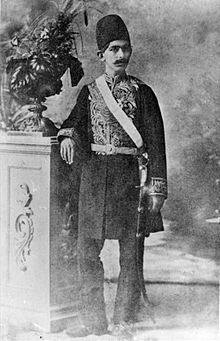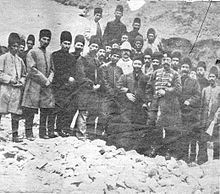- Mahmoud Afshartous
-
Mahmoud Afshartous also written Afshartoos (* 1908 in Tehran; † April 24 1953 Tehran) was an Iranian general and chief of police during the government of Prime Minister Dr. Mohammad Mossadegh, who became one of the heroic figures in Iran's struggle for democracy and of the coup d'état 1953 due to his murder by the Shah's agents .
 General Mahmoud Afshartous
General Mahmoud Afshartous
Contents
Family Background
Mahmoud Afshartous came from a Persian noble family who was close related to the Qajar dynasty.
Paternal Family
His father was Hassan Khan Afshartous (Qajar-Qovanlou) Shebl as-Saltaneh, the sixth son of Amir Isa Khan Vali Ehtesham ad-Dowleh, son of Amir Mohammad Qassem Khan Qajar-Qovanlou Amir Kabir and youngest (half-) brother of Mehdi Qoli Khan Amirsoleymani Majd ad-Dowleh. Therefore, Shebl as-Saltaneh was the youngest scion of the famous and powerful Qovanlou branch of the Persian Qajar dynasty and a maternal cousin to Naser al-Din Shah Qajar.[1] His career at court started as private adjutant (Persian ağūdān-e hozūr-e homāyūnī) to Naser al-Din Shah Qajar, by whom he also got his aristocratic title Shebl as-Saltaneh ("Lion Cub of the Monarchy") and whom he accompanied on several trips. Later he held many posts in administration, including that of governor of the Afshar tribe of the city of Tous in the Iranian province of Khorasan. His mother's family originated from this area and thus he chose the family name "Afshar-Tous" or "Afshartous", when family names were mandated in 1930.
Maternal Family
Mahmoud Afshartous' mother was Banou Fatemeh Soltan Khanom. She descended from the Zarrinnaal line of the Zarrin Kafsh tribe, a dynasty of local Persian-Kurdish tribal chiefs and officials. Her father Agha Mirza Zaman Khan Kordestani came from Sanandaj in the Iranian province of Kordestān to Naser al-Din Shah's court, was appointed muster-master of the troops (lashkar-nevis) and married her mother Pari Soltan Khanom Pir-Bastami from the Moayyeri clan, a niece of Naser al-Din Shah. Her two brothers Agha Mirza Ali Akbar Khan Zarrinnaal Nasr-e Lashkar and Mirza Ali Asghar Khan Zarrinkafsh themselves made their names under the Qajars and later Pahlavi dynasty.[2]
Mahmoud Afshartous had seven brothers (Shebl al-Mamalek, Khan-Khanha, Mohammad Sadegh, Mohammad Bagher, Morteza, Mostafa and Ali) and two sisters (Akhtar as-Saltaneh and Banou Ozma) who bear the surname of Afshartous or Afshartoos and the family married into the Amirsoleymani and Zarrinkafsh families.[3]Relations with the Pahlavis
Mahmoud Afshartous was related to the Pahlavi dynasty via Queen Touran Khanom Amirsoleymani (Qajar-Quvanlou) Qamar al-Molouk. Queen Touran was the third wife of Reza Shah and mother of Prince Gholam Reza Pahlavi; on one side she was related to Afshartous' own father on the other side she was a cousin to Afshartous' second wife Fatemeh Bayat, who was Mossadegh's grandniece, as well.[4]
Career
After the Constitutional Revolution of 1906, Afshartous' father Shebl as-Saltaneh became very worried about the political situation in Iran and left 1909 the country for a while. His older brother took care of him and inspired Afshartous to have a military education. So Afshartous studied with diploma at the Nezam High School and entered military service as young cadet of the Tehran Military University. In 1936 he was introduced to Reza Shah by Two-Stars-General (sar-lashkar) Karim Buzarjomehri, and got his first job as chief of the royal property (amlak-e saltanati). Later he became member of the artillery corps and was promoted into the rank of One-Star- or Brigadier-General (sartip) of the Imperial Iranian Forces. As an able man he was made military governor of Tehran by Mohammad Reza Shah Pahlavi. He took many steps against corruption inside the army. It was also during this period that General Afshartous who was among the companions of his granduncle Mossadegh formed the National Front (jebh-e melli) under Mossadegh's leadership. In July 23 1952 he was appointed chief of police of Iran when Mossadegh was prime minister.[5]
As a person extremely quiet, very firm and disciplined, who had nearly no close friends, he determined for a change in the political system of Iran. He was engaged against corruption and especially bribery in military. Many times he dismissed different graded officers in order to defend transparency and believed that certain officers have to promote only up to certain levels otherwise they rotten. All and all his idea was based on transparency and honesty and he refused to compromise, for this reason he had many enemies.A loyal supporter of Mossadegh, often called his "right hand" and very popular in the people's eyes he became too powerful and a threat for those political circles around Mohammad Reza Shah Pahlavi, who feared to loose the absolute power.[6]
Circumstances of his Death
When Prime Minister Dr. Mohammad Mossadegh the leader of the National Front, a liberal democrat and an ardent nationalist, more and more governed without parliament to reduce the Shah's power, some politicians feared the democratic measures will end in despotism. Finally Mossadegh using emergency acts to reach his aim in nationalizing the Iranian oil industry organized a plebiscite to close parliament. The opposition saw in this fact a sign that he would ally with the communist Tudeh party, became a Soviet affiliated dictator and wanted to abolish the monarchy system in Iran. Thus, in March of 1953, the Imperial court with the help of a group of clergies, expelled army officers, and politicians decided to perform a conspiracy plan against the prime minister.[7] Mozaffar Baqai, founding member of the Iranian Toilers’ party and a former companion of Mossadegh allied with General Fazlollah Zahedi, a close friend of the Shah, to depose Mossadegh. But first of all to prepare the coup the loyal police apparatus had to been eliminated. The conspirators gathered in Baqai's house and planned to murder the prime minister's able chief of police. Thus, Mahmoud Afshartous was kidnapped after being lured into Hossein Katibi's house for a meeting. He was later brought to the mountains near Tehran to be tortured and strangulated to death by the Shah's agents headed by Khatibi on April 24 1953. Furthermore Khatibi affirmed that documents had been found with Afshartous indicating a general arresting of all US-agents and Shah's supporters in Iran. Afshartous' fate was sealed and the plot against the democratically elected prime minister ended with the CIA-sponsored coup d’etat of August 19 1953 later known as "Operation Ajax".[8][9]
Afshartous was posthume promoted into the rank of a Two-Stars-General by Mossadegh and his grave-yard was situated in Tehran's Tajrish-Square, at the Reza-Pahlavi-Hospital (at the beginning of the Islamic Revolution called "Afshartous Hospital" and now named Shohada Hospital – Martyr Hospital).
The Shah sent his half brother Prince Gholam Reza Pahlavi, Touran Khanom's son, to Banou Fatemeh Soltan's house as envoy and representative of the Pahlavi monarchy to condolence Mahmoud Afshartous' family. But Banou Fatemeh Afshartous, then an old little lady out of grief for her dead son, bravely asked the prince: "I am wondering that my son's murderer sent you to come here. What did my son do wrong than only being a real patriot who loved his country? What did my son do wrong in the eyes of his murderer, the Shah, your brother?" Ashamed the prince left that funeral come together and the family cut officially any relations with the Imperial court.References
- ^ M. Eskadari-Qajar: Qovanlou Qajar Genealogy, in: The Qajar (Kadjar) Dynasty Pages [1]; F. Barjesteh: "Mistaken Identities", Appendix B, in: Journal of the International Qajar Studies Association, Vol. II, 2002, p. 111; K. Mo'tazed: Nakaman-e Kakh-e Sa'adabad, Vol. 2, 2005, p. 693 f.
- ^ A. Zarrinkafsch: "Transition of Tribal Nobility to Urban Elite", in: Qajar Studies: Journal of International Qajar Studies Association, Vol. VIII, 2008, p. 97 ff.
- ^ A. Zarrinkafsch: The Zarrinkafsch (Bahman-Qajar Webpage [2]
- ^ B. Farman Farmaian: "Shirzan - The Lioness", in: Qajar Studies: Journal of International Qajar Studies Association, Vol. VIII, 2008, p. 129.
- ^ K. Mo'tazed: Nakaman-e Kakh-e Sa'adabad, Vol. 2, 2005, p. 699.
- ^ S. Farman-Farmaian: Daughter of Persia, 1992, p. 217.
- ^ [3]
- ^ A. Milani: Eminent Persians, 2008, Vol. 1, p. 112 ff.
- ^ TIME-Magazine: In a Persian Alley, Monday, May 04 1953[4].
Literature
Barjesteh van Waalwijk van Doorn (Khosravani), L.A. Fereydoun: "Mistaken Identities: Anoushirvan (Shir) Khan (Qajar Qovanlu) 'Eyn ol-Molk' 'Etezad od-Doleh' and Prince Ali Qoli Mirza 'Etezad os-Saltaneh'" , in: Journal of the International Qajar Studies Association, Vol. II, Rotterdam 2002, p. 91-150.
Eskadari-Qajar, Manoutchehr M.: Qovanlou Qajar Genealogy, in: The Qajar (Kadjar) Dynasty Pages [5]
Farman Farmaian, Bahman: "Shirzan - The Lioness. A Narrative Sketch of Princess Malek-Taj Qajar 'Najmeh os-Saltaneh'", in: Qajar Studies: Journal of International Qajar Studies Association, Vol. VIII, Rotterdam 2008, p. 124-147.
Farman-Farmaian, Sattareh; Dona Munker: Daughter of Persia: A Woman's Journey from her Father's Harem through the Islamic Revolution, New York 1992.
Milani, Abbas: Eminent Persians, Syracuse University Press, 2008, Vol 1.
Mo'tazed, Khosrow: Nakaman-e Kakh-e Sa'adabad (The Unlucky of the Sa'adabad Palace), Vol. 2 (2), Tehran 1374 h.š. (2005).
Zarrinkafsch (Bahman-Qajar), Arian K.: "Transition from Tribal Nobility to Urban Elite: the Case of the Kurdish Zarrinnaal Family", in: Qajar Studies: Journal of International Qajar Studies Association, Vol. VIII, Rotterdam 2008, p. 97-123.
Zarrinkafsch (Bahman-Qajar), Arian K.: The Zarrinkafsch (Bahman-Qajar) Webpage [6]
Categories:- Iranian generals
- Iranian families
Wikimedia Foundation. 2010.




